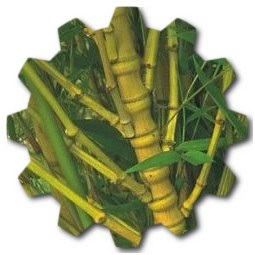What are some fun facts about Bambusa?
“Bambusa” is a genus of giant clumping bamboo plants belonging to the grass family Poaceae. Bamboos are known for their rapid growth and versatile uses. Some Bambusa species produce edible bamboo shoots, which are harvested for culinary purposes in certain cultures. These shoots are a common ingredient in various Asian dishes. In summary, Bambusa refers to a genus of clumping bamboo plants known for their rapid growth, versatile uses, and importance in various cultural and ecological contexts
It has erect stems with yellow colored hard and dense leaves. 10 cm. It has sharp leaves like a knife in length. Can grow in shade. They spread with an elongated and clustered root system. It can grow in all types of soil as long as there is enough moisture. In drought, the leaves of the plant dry up. Bambusa is a genus of bamboo, and bamboo plants are fascinating in their own right. Here are some fun facts about Bambusa and bamboo in general:
- Rapid Growth: Bamboo, including Bambusa species, is known for its incredible growth rate. Some bamboo species are among the fastest-growing plants in the world, with certain varieties capable of growing up to 35 inches (90 cm) in a single day under ideal conditions.
- Versatility: Bamboo is one of the most versatile plants on Earth. It has a wide range of uses, including building materials (bamboo scaffolding and flooring), furniture, paper, musical instruments (such as flutes), textiles, and even as a food source in some cultures.
- Strength: Bamboo is incredibly strong, with some species having a tensile strength similar to that of steel. This makes it an excellent choice for construction, particularly in earthquake-prone regions.
- Hollow Stem: Bamboo stems are typically hollow, which reduces their weight while maintaining strength. This hollow structure aids in its growth and makes it useful for many applications.
- Culinary Uses: In certain Asian cuisines, bamboo shoots are a popular and delicious ingredient. They are often used in stir-fries, soups, and other dishes.
- Panda’s Diet: The Giant Panda, native to China, primarily feeds on bamboo. Their diet consists mainly of various bamboo species. This is one of the reasons why bamboo conservation is crucial for panda populations.
- Symbolism: Bamboo holds cultural significance in many Asian societies. It is often associated with strength, resilience, and flexibility. In some cultures, it symbolizes longevity and good luck.
- Sustainable Material: Bamboo is considered an eco-friendly and sustainable material. It grows quickly, requires minimal pesticides, and can be harvested without killing the plant. This makes it an excellent choice for sustainable living.
- Noise Reduction: Bamboo can be used as a natural sound barrier. Its dense growth and tall canes make it effective in reducing noise pollution in urban and suburban environments.
- Bamboo Forests: Some bamboo forests are famous for their serene beauty and unique atmosphere. The Sagano Bamboo Forest in Kyoto, Japan, is one such example, attracting visitors from around the world.
- Bamboo and Paper: Bamboo pulp is used in paper production in many parts of the world. It produces high-quality paper that is smooth and durable.
- Bioenergy: Bamboo is a potential source of renewable energy. It can be used for bioenergy production, such as generating biomass fuel or biochar.

Bambusa and other bamboo species are not only important for their practical uses but also for their cultural, environmental, and ecological significance. Their rapid growth, strength, and versatility make them an incredible and multifaceted plant family.
What is the Bambusa aurea bush? What is it used for?
Bambusa aurea, commonly known as Golden Bamboo, is a clumping bamboo species that is highly valued for its ornamental qualities and various practical uses. It is known for its striking golden or yellow canes and is a popular choice for landscaping and gardening. Here’s some information about Bambusa aurea and its uses:
1. Appearance:
- Canes: The canes of Golden Bamboo are typically bright yellow or golden in color, which is one of its most distinctive features. These canes can grow tall and straight, adding an attractive vertical element to the landscape.
- Foliage: The bamboo features dark green, lance-shaped leaves that complement the golden canes.
2. Size:
- Bambusa aurea can reach heights of 15 to 30 feet (4.5 to 9 meters) or more under ideal conditions. The actual height can vary depending on factors like growing conditions, climate, and care.
3. Uses:
- Ornamental Plant: Golden Bamboo is highly valued as an ornamental plant. Its vibrant canes and lush foliage make it a striking addition to gardens, landscapes, and as a decorative potted plant.
- Privacy Screen: The dense growth of Golden Bamboo makes it an excellent choice for creating privacy screens, hedges, or windbreaks. When planted closely together, it can effectively block views and create a secluded area.
- Erosion Control: Due to its robust root system, Golden Bamboo can help prevent soil erosion on slopes and riverbanks.
- Culinary Uses: The young shoots of some bamboo species, including Bambusa aurea, are edible and used in various Asian cuisines. These bamboo shoots, when properly prepared, are used in stir-fries, soups, and other dishes.
It’s important to note that Bambusa aurea is a clumping bamboo, meaning it doesn’t spread as aggressively as running bamboos, which can become invasive. However, it’s still important to monitor its growth and maintain it within the desired boundaries in your garden. Additionally, the use of bamboo shoots for culinary purposes should follow safe and culturally appropriate preparation methods.
Golden Bamboo’s striking appearance and versatility make it a popular choice for both decorative and practical purposes in landscaping and gardening.





